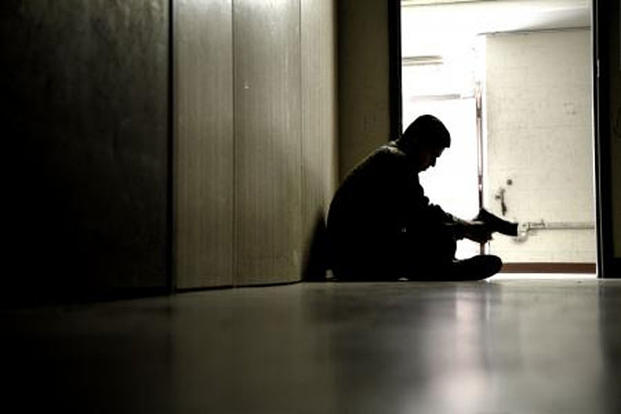Post-traumatic stress disorder carries him into the depths of fear and pain; reliving images of death and destruction. Closing his eyes to night terrors at sundown and fighting through daily anxiety attacks eventually pushed him to the brink of suicide so he could put an end to the never-ending cycle.
It wasn’t until his second suicide attempt that Air Force veteran and Air Force Installation and Mission Support Center support agreement manager Ryan Kaono took steps to face his invisible scars and reach out for help.
It was 2010 and he hadn’t slept in more than four days, knowing he’d get flashbacks of what he’d experienced during deployments to Saudi Arabia and Iraq.
“They were terrible,” Kaono said. “I would wake up screaming and my wife would be scared. Out of desperation, I decided I was going to end it.”
Kaono’s wife, Alessa, said it was very difficult for her to watch her husband suffer with no real diagnosis.
“You feel helpless,” she said. “I described it as having an animal or child unable to speak yet you know they’re feeling something. You see a look in their eyes that they’re suffering but you don’t know what you can do to help them.”
Exhausted and going through myriad feelings, Kaono swallowed numerous prescription drugs in the hopes of not waking up. Something inside him, however, made him reach out to his commander for help, letting her know what he’d done.
He was admitted to the Los Angeles Veterans Affairs hospital for a few days of observation and diagnosed with PTSD. This began his journey of living with the disorder instead of being a slave to it.
His diagnosis came with some relief but angst as well.
“I was scared yet relieved at the same time,” Alessa said. It was a roller coaster of emotions. I was happy he was finally diagnosed but both he and I knew it would be a long and difficult journey at times.”
Even today, two deployments replay in the mind of the former security forces military working dog handler and logistician.
Khobar Towers, Saudi Arabia
In June 1996, Kaono was working a gate at Khobar Towers, Saudi Arabia, when a vehicle-borne improvised explosive device detonated on the other side of the compound, killing 19 and wounding countless others.
“When the actual blast went off, it was chaos everywhere,” Kaono said. “I had to stop and put that part behind me. I needed to focus and ensure that the folks who had been injured or disoriented … were taken care of.”
For years, he continued pushing the many visions of pain and suffering he’d seen there to the back of his mind where they festered.
In total, the Hawaii-native had 11 deployments as a security forces defender by the time he found himself at Ramstein Air Base, Germany, struggling with anger issues.
“I would quickly get frustrated; I would have bouts of just frustration and real anger,” he said.
While on a smoke break outside of central security control one day, Kaono lost consciousness and fell to the ground. Controllers inside the building were able to see what happened and his officer-in-charge ran to his aid.
When he regained consciousness, his captain was leaning over his chest, trying to wake him.
He was quickly taken to the hospital where he suffered with partial paralysis in his legs for about 10 hours and the inability to use his body from the base of his neck to his fingertips for three days.
His medical team diagnosed him with syncope; the uncontrollable loss of consciousness with no real explanation.
“From that, they determined I couldn’t deploy, I couldn’t carry a weapon so I couldn’t really be a security forces member anymore,” Kaono explained. “I was force retrained for medical reasons into logistics.”
Balad Air Base, Iraq
Fast forward to 2005 when Kaono served as first sergeant and deployment manager for the 93rd Aircraft Maintenance Squadron in Balad, Iraq.
As a dual-hatted logistics planner and first sergeant in the Reserve, he was responsible for making sure unit members arrived safely at their deployed location, were able to get their jobs done and would return home to Homestead Air Reserve Base, Florida, when their deployment was over.
While in a meeting with senior leaders, the base began taking mortar fire that impacted closer and closer to Kaono’s trailer and two fully-loaded F-16s nearby.
“They were trying to walk (mortars) up our runway to our loaded aircraft,” Kaono said, with the expectation that they’d be able to hit the aircraft causing secondary explosions with more damage.
While everyone in the room was running for cover, Kaono gathered up classified materials to stow in a safe.
“It wasn’t my first mortar attack so I really didn’t think anything of it,” he said.
With the sensitive documents in the safe, Kaono turned to leave to seek shelter when a mortar pierced the aluminum trailer and exploded, sending him 15-20 feet in the air before slamming his head and right shoulder into a concrete Jersey barrier.
“It felt essentially like The Matrix … I’m floating through the air and everything is going in slow motion. I see shrapnel and dust and everything just going around me,” he said.
Once he hit his head, he was snapped back to reality and felt the severe pain of what would later be diagnosed as a traumatic brain injury.
“I went to the hospital there at Balad and they checked me out and told me I had a concussion but that was about it; nothing really life threatening so I didn’t get sent home,” he said.
When he eventually rotated back to Homestead, he went through a standard post-deployment physical health assessment where he initially struggled with discussing what he’d endured. When he was able to talk about it, the doctor said he entered what was considered a fugue state – a complete loss of what was going on around him.
“I essentially was staring off into nothingness for a period of time suffering a flashback,” he said.
“From there, they said I had a possibility of PTSD and they sent me on my way.”
Five years later, after his extreme cries for help, his PTSD diagnosis came.
PTSD, the daily struggle
“PTSD and living with it is a daily struggle,” Kaono said. “We’re always cognizant of it. Those who are around us may see us and see absolutely nothing’s wrong. We don’t typically have external signs of our disability but emotionally and mentally, we still have to deal with it.”
In the years between 1996 and today, Kaono said there were times when he would just shut himself away because he didn’t want to be a burden on anyone. There were also times when he could go to work and feel that people would think there was nothing wrong with him because he looked fine.
“That just reinforced the issue that I had,” he said. “To me, one of the main issues of dealing with PTSD is that people don’t (realize) … they don’t see you missing a limb, they don’t see you scarred, they don’t see you burned and so to the outside world you look like you’re no different -- you’re not special, you have no issue, no disability to really claim.”
In order to live his life, Kaono has to acknowledge his PTSD and what caused it every single day.
“If I continued down the path that I was on previously, where I just let it consume me, I wouldn’t be here today,” he said.
The U.S. Department of Veterans Affairs estimates 31 percent of Vietnam veterans, 10 percent of Gulf War veterans, 20 percent of Iraqi war veterans and 11 percent of veterans from the war in Afghanistan live with PTSD.
To be able to help them, Kaono recommends people educate themselves on the disorder.
“Find out what post-traumatic stress is, see what it does, look at the studies that show why there are 22 people per day committing suicide because they can’t handle the stress anymore. Don’t just pass us off as being fine … that’s the worst thing that people can do.”
On top of everything else, dealing with the stigma of having PTSD is a struggle for the Kaono family.
“When people hear the word PTSD they think of the negative news articles out there. Ryan may have PTSD, but it doesn’t make him any less of a human being,” Alessa said.
“We’re not asking people to walk on eggshells around us," Kaono said. "Treat us as if you would treat anybody else … we are still people. We still hold jobs. We still have families. We still have responsibilities and if you don’t give us the opportunity to meet those responsibilities, you’re not helping us.”















